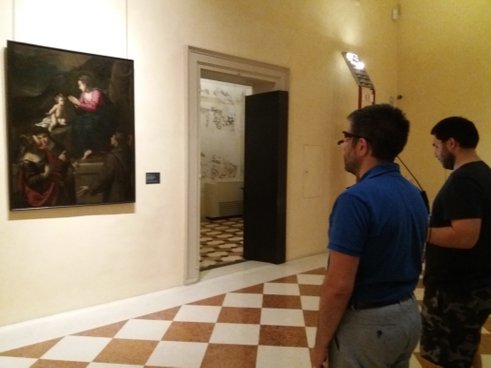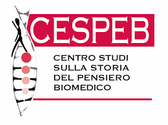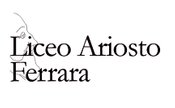READ MORE
Project NEVART
Neuroaestethics of the Art Vision
This new CIAS project, developed thanks to the collaboration of the CESPEB Neuroaesthetic Laboratory and the CNR Neuroscience Institute of Parma, focuses on the processes through which people appreciate works of art.
The 'neuroaestethics' wants to deepen the neurophysiological bases that allow a work of art to be perceived as 'appreciated' or not and/or 'pleasant' or 'unpleasant'.
In this perspective, the artworks of "Painting the affections" and the halls of the Estense Castle, will become a real place of experimentation in 2019.
Art and science will find a link to enhance the artistic experience and, at the same time, to gather useful information both from a neurological and a technological point of view.
Since late July to the end of December 2019, the CIAS collected online applications from those interested in joining the project, wearing a set of sensors needed to record the multi-sensory experience while viewing the exhibition.
The tests already ended and we are now proceeding with the analyzes of the data; the first results will be available as soon as possible, together with the program of new experimental researches that are emerging, starting from this first project.
Research team
The study is coordinated by the CIAS Interdepartmental Research Centre of the University of Ferrara, principal investigator (team: Sante Mazzacane, Maddalena Coccagna, Giuseppe Camillo Santangelo, Arianna Vivarelli, Silvia Cesari, Davide Orlando, Gabriele Martini, Matteo Bisi, Antonella Volta, Luca Lanzoni).
Take part of the study also:
-
CESPEB Neuroaesthetic Laboratory (Study Center on the History of Biomedical Thought): Vittorio Sironi, Raffaella Folgieri, Annalisa Banzi
-
Institute of Neurosciences of the CNR of Parma: Pietro Avanzini, Maddalena Fabbri Destro, Giovanni Vecchiato
-
Department of Humanities of the University of Ferrara: Andrea Gatti, Filippo Domenicali
-
Department of Humanities and Philosophy of the University of Florence: Mariagrazia Portera
-
SE@, Center for Technologies for Communication, Innovation and Distance Learning at the University of Ferrara: Giovanni Ganino, Filippo Landini
-
Municipality of Ferrara, curators of the exhibition "Painting the affections": Giovanni Sassu, Romeo Cristofori
-
Municipality of Ferrara, Responsible of the U.O. Estense Castle: Ethel Guidi
-
Fancy Pixel, spin-off of the University of Ferrara
- Soluzioni Digitali, Paolo Ferrara
-
Ferrara Arte Foundation
-
Consorzio Futuro in Ricerca
Partnerships
The project could not take place in its breadth and complexity without the numerous external partnerships which, over time, provided advice, training and provided scientific contributions.
We apologize in advance if, in the site update, we will forget someone; we want to thank:
-
Fabio Bevilacqua (restorer)
-
Rita Tagliati (journalist)
-
Pierluigi Montanari
-
Lisa Galbussera and Valerio Tateo (Moellhausen spa)
-
Valeria Tugnoli (Operative Unit of Hospital Neurology, Arcispedale S.Anna of Ferrara)
-
Paolo Boldrini (neurologist, Italian Society of Physical and Rehabilitation Medicine)
-
Fabrizio Salvi (neurologist, IRCCS Neurological Sciences of Bologna)
-
Paolo Zamboni (Department of Morphology, Surgery and Experimental Medicine, UniFe)
-
Carlo Alberto Tassinari (neurologist)
-
Ezechiele Foschini (Department of Biomedical and Neuromotor Sciences, UniBo)
A growing project
As in all CIAS projects, this study has a multidisciplinary and multimedia approach in a specific research field, neuroaesthetics, using a strictly integrated method combining scientific topics (neurology, sensors, computer science, electrophysiology, psychology etc.) and humanities (from aesthetic philosophy to historical-artistic subjects), with the aim, among others, of involving young people from high school, here the Ludovico Ariosto High School in Ferrara.
We thank the head, teachers and tutors of the High School (Mara Salvi, Caterina Pieri, Stefania Borini, Francesca Papaleo and Anna Maria Masi) and the students involved (Antonucci Giulia, Bellagamba Sebastiano, Biagini Angelica, Camattari Anna, Cersamba Stefania, Govoni Sara, Greco Elisa, Morbini Cecilia Costanza, Ongaro Mirca, Piva Virginia, Salzano Carlo, Zagatti Giulia).
The phases of dissemination of the project include ad hoc meetings, the publication of scientific papers and the video-documentation of the project, thanks to the key contribution of the SEA (Center for technologies for Communication, Innovation and Distance Education of the University of Ferrara), which will take care of recording the main phases of the research and translate them into videos, suitable for a non-expert audience.











